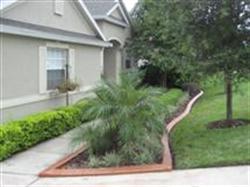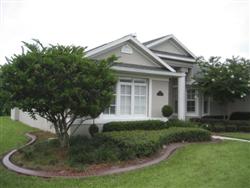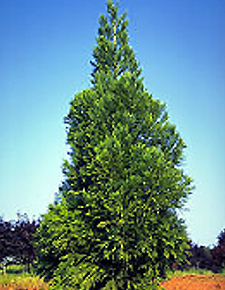







Kwik Kerb Curbing
Landscape Design
Ground Cover
Landscape Lighting
Pressure Cleaning
Irrigation
Patios, Walks and Walls
Decks, Arbors and Pergolas
Recent Projects


Landscaping Design: Trees
One of the best investments you can make in your yard is landscape trees. The US Department of Energy has noted that an 8-foot tall deciduous tree (one that sheds its leaves) costs about as much as an awning for one large window. But the tree will save hundreds of dollars in reduced cooling costs while still letting winter sun into the home to further save on heating and lighting costs, not to mention the trees look, feel and beauty.
Trees provide the backdrop for your garden plantings, reduce noise pollution, screen unwanted sights from view, provide a haven for birds and bring color and visual interest throughout the seasons.
Trees can be grouped into two general categories: deciduous and evergreen. Within these general groupings, horticulturists have grouped them into genus defined by Latin names. Some of the common types of trees found in North America are:


Deciduous: Sometimes called hardwoods, these trees lose their leaves in the fall. They include maples (acer), birch (betula), dogwood (cornus), crape myrtles (lagerstroemia), crabapple (malus), plums and cherries (punus), pears (pyrus), oaks (quercus), willows (salix) and elms (ulmus).
Non-Deciduous: Evergreen trees include such genus as cedars (cedrus), japanese cedar (cryptomeria),cypress (cupressus) hollies (ilex), junipers (juniperus), magnolia (although some, like the tulip magnolia, are deciduous), pines (pinus), hemlocks (tsuga). They remain evergreen by replacing their leaves while the old leaves are still on the tree. (The old leaves then turn brown and fall off). Those that have cones are called conifers. Evergreens are excellent choices for screening and are used as natural fences to block wind, noise and view.
Trees grown for the nursery trade are generally available in two forms: balled and burlapped (B&B) and container grown.
Balled and Burlapped Trees produced this way get their name from the method of harvesting. They are field grown and when it is time to prepare them for sale, they are dug up (either manually, or more commonly with a mechanical clamshell tree spade). Once out of the ground, the root ball is placed in an open steel cage (balled) and wrapped in burlap. The cage has loops at the top for easy attachment of hooks for transport. The burlap holds in soil and moisture. When it is time to plant the tree, (harvesting is best in late fall through early winter), the tree is planted in the ground, basket and all. By the time the roots are grown out, the metal basket has rusted away and the burlap has turned to mulch.
Container Container grown plants have the advantage of being able to be planted at almost any time of the year, the shock of transplanting is minimized because the root system stays largely in tact (unlike B&B, where part of the root system is lost, particularly for larger trees.) At the same time, there is a practical limit to how large a tree can be grown (and remain) in a container before it is too large and too heavy to conveniently handle. The norm for the large container is 20 gallon, yielding a tree of 5 -8 depending on the variety. If left too long in the container, the tree roots begin to wrap around themselves (a process called girdling). When this happens, the tree can literally strangle itself as it grows larger.
As a precaution, container grown trees are removed from the container and the roots inspected, untangled and in some cases even sliced to ensure that they are free to grow without damaging the tree.
Trees are a wonderful way to add appeal to your landscaping area. There are many important questions you will need to ask yourself prior to planting such trees. First, take a look at how much room you have. You will need to consider the growth the trees will have over time. Another key factor to consider is how the trees will look during each season. This can have quite an affect on the look of your landscaping during the various seasons.
Choosing the right trees for your landscaping is not easy. There are many factors to contend with. You want to choose trees that grow well in your area and that are appealing during different seasons. It can get quite tricky once you start adding different trees. It is important to consider their size as well as how they will look next to each other. You will want to discuss this with a qualified landscaper or do the research yourself on the internet. You might also consider purchasing landscaping design software to visually show you have the trees will look.

